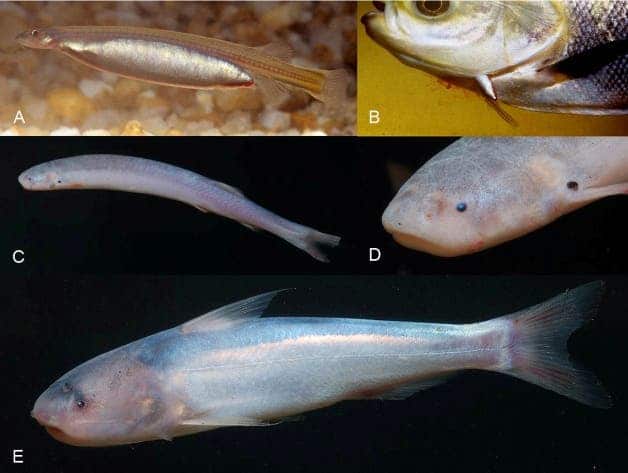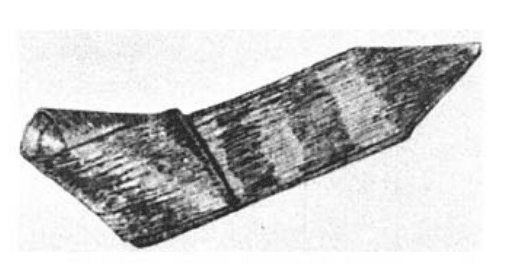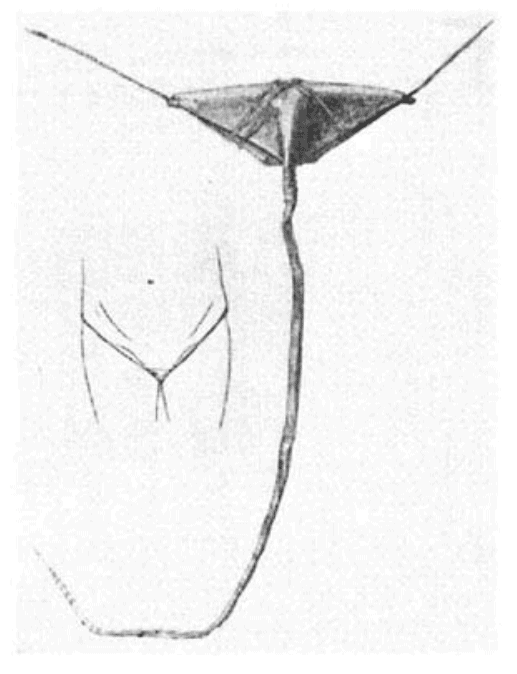The Amazon is the greatest flowing river on Earth, which weaves through one of the most vital and complex ecosystems in the world. But beautiful and life-giving as it may be, the Amazon is also home to many dangerous, sometimes gruesome creatures.
If you’re keen on traveling off the beaten path in the Amazon rainforest, there’s a good chance you might run into a black caiman, jaguar, electric eels, maybe even piranhas. But perhaps the most frightening creature of them all is candirú, the penis burrowing fish. Yes, you read that right.
Just reading about what the candirú can do when it swims up the urethra, vagina, or rectum is enough to send chills down your spine. But although locals and tourists alike are terrified by the candirú, many biologists and scholars believe its terrifying reputation is more myth and legend than fact.
The tiny catfish nightmares are made of
The candirú is a catfish of the genus Vandellia, the most typical and widespread species being Vandellia cirrhosa — for all intents and purposes, it’s this species that we’re referring to when discussing the candirú, as it is known to Brazilians or the canero as Spanish speakers call it.
It is a slender, transparent fish about 3–5 cm long, though some specimens may grow up to 20 cm. In fact, it’s one of the tiniest vertebrates in the world, its slender appearance earning it the nickname the “toothpick fish”.

The candirú is a parasite that primarily lurks on the murky bottom of the river, where it stalks other fish to feast on their blood. Because there is little light, the candirú is thought to track prey by following traces of urea and ammonia expelled from breathing gills.
Once it catches up with its prey, the fish fastens to the victim using its disproportionately large, expansible, disc-like mouth, lined with opercular spines. Within a fraction of a second, the agile parasite penetrates the gill and wriggles its way in using its umbrella-like array of painful spines to firmly anchor itself in position, while it draws blood from its bounty.
Within two minutes, its belly is swollen with blood. When satisfied, the invader retracts its gripping barbs and returns to the bottom of the river to digest its meal, though some stay lodged in the gills almost indefinitely. Its traumatized victim, however, is left severely bruised and may even succumb to its wounds, even though the victim can be tens or hundreds of times larger.
In fact, even though they’re millions of times heavier, humans are petrified of this tiny fish because of the debilitating damage it can supposedly cause to their precious crotches.
Locals in the Amazon often warn travelers not to, under any circumstances, urinate while bathing or swimming in the river. Doing so invites the risk that this slender catfish might be attracted by the urea and ammonia and immediately travel up the urethra, which it may mistake for the gill of some weirdly-shaped but nevertheless tasty large fish, or so the story goes.
Once it swims up the urethra, the candirú proceeds with its nasty business, as usual, wriggling its way in as far as possible. Its slippery, mucus-coated tail makes it virtually impossible to pull it out in time before it disappears inside the person’s penis, vagina, or rectum. And if the victim does manage to grab the fish, its backward-pointing barbs would deliver excruciating pain with each tug. Once inside, the parasite bites through until it finds an ample blood supply and starts feeding. Some claim it swims up the bladder, where it makes a new home and starts laying millions of eggs. The human victim just got raped by the fish, or so they say.
“They always swim against the current so that they get into the water which is squeezed through the gills in the larger fish which they parasitize…. The candirus penetrate the urethras of bathers who urinate in the water. Since the fishes have gill cover spines pointed to the rear, it is
already too late once their presence is noted since they cannot simply be pulled out. This has reportedly caused death. If the afflicted individual does not want to have blood poisoning he must undergo an amputation,” reads a chapter in Grzimek’s Animal Life Encyclopedia, published in the 1970s.
There is little the victim can do to end this nightmare — not without making it worse. Such a dramatic fate invites an over-the-the-top treatment, perhaps involving pulling the fish out with pliers with accompanying unimaginable agony for the host, or surgery on the penis — perhaps even an amputation. Dr. Charles Ammerman, a U.S. Naval surgeon on the Madeira River, which crosses Brazil and Bolivia, claimed that he operated on several patients to remove candirú between 1910 and 1911. Professor Starks, an ichthyologist at Stanford University, later met Ammerman in the Philippines in 1926 and later wrote:
… he had operated for it two or three times … In one instance he tried to pull a fish out of a patient’s penis but the tail pulled off and he had to operate, making a suprapubic opening into the bladder to remove the fish which had penetrated into that organ.

Other remedies are far less extreme, such as inserting pieces of the huito fruit (Genipa americana) inside the pee-pee hole or drinking hot tea made of it. The fruit’s acidic properties supposedly dissolve the fish. A 1941 article in the American Journal of Surgery related the following case of a 13-year-old boy:
“The fish had entered his penis, and by the time the young Indian had reached the mission a half hour after the attack his trousers were saturated with blood, and it was running over his bare feet. He seemed to be in considerable pain. Mr Burns, fearing that he might not succeed as the Indians do with their huito juice, said that he had no medicine for such cases. He suggested that they treat the boy according to their own customs and lost no time in sending the Indians for the fruit. This time they had to cross the river, over one-fourth of a mile wide at this point, to get green
fruit. There was plenty of ripe fruit at hand, but this is not suitable for the treatment. The men brought the green fruit, prepared it, and gave the boy a good drink, about a pint, of the unpalatable medicine. This, of course, could be prepared in varying strengths. The next day, hearing that the boy was very weak from loss of blood, Mr Burns went to his house and was told that the fish was dislodged about two hours after the potion was administered. The boy was still suffering with a slight hemorrhage, and micturition was painful. However, he recovered completely.”
Because of the danger posed by the candirú, natives have come up with all sorts of customs to prevent an attack. The curator of the Fishes in the British Museum has summarized descriptions of such customs made by Dr. Bach, a physician on the Jurua River in the 19th-century, as follows:
“The Candyu, as the fish is called, is much dreaded by the natives of the Jurua district, who, in order to protect themselves, rarely enter the river without covering their genitalia by means of a sheath formed of a small cocoanut-shell, with a minute perforation to let out urine, maintained in
a sort of bag of palm-fibers suspended from a belt of the same material. The fish is attracted by the urine, and when once it has made its way into the urethra, cannot be pulled out again owing to the spines that arm its opercles. The only means of preventing it from reaching the bladder, where it causes inflammation and untimely death, is to instantly amputate the penis; and at Tres Unidos, Dr. Bach had actually examined a man and three boys with amputated penes as a result of this dreadful accident.”
Eugene Willis Gudger, one of the world’s foremost ichthyologists of the early 20th century, dedicated many comprehensive articles and even an entire book, The Candiru (1929), to this menacing fish. He also describes various penis protectors worn by men, such as the inoba, which is made of strips of dried palm leaves, and a modified device made of bark, called uluri, worn by women.


All of this sounds absolutely horrible. But there’s a catch.
If it sounds too crazy to be true, it usually isn’t
There are many things that don’t add up with the many gruesome stories of supposed attacks on humans. The size of the fish would certainly allow it to slip up the tip of the urethra, but given the lack of oxygen and cramped space, it is very unlikely the fish could survive for more than a minute. Most certainly, it cannot make a ‘home’ there or swim further upstream to the bladder.
With all the panic and sheer terror across the Amazon basin of encountering a candirú, it’s telling that there is only a single modern documented case of a human attack. The highly publicized case happened in 1997 in Brazil to a man, who told the press:
“I felt like urinating. I stood up, and it was then it attacked me. The candirú attacked me. […] When I saw it, I was terrified. I grabbed it quickly so it couldn’t go deeper inside. I could only see the end of its tail flapping. I tried to grab it, but it slipped away from me and went in. […] I was very afraid, because the candirú bites.”
The victim was supposedly lucky enough to find a nearby urogenital surgeon, who performed a successful operation and extracted the terrorizing fish.
However, this is at most semi-credible. The victim’s story is too inconsistent with the facts, such as his insistence that the fish jumped out of the water and ascended the urine column up his urethra. And there are very few images and drawings of the candirú, let alone footage from what should have been a historic event of medical science.
In a review published in the Journal of Travel Medicine, Irmgard Bauer, a researcher at the School of Nursing at James Cook University in Australia, scoured all the scientific literature on the candirú he could find, as well as looked at numerous nonscientific materials such as news reports on the web. Bauer found that the first mention of the candirú was made by Carl Friedrich Philipp von Martius (1794–1868), followed by similar reports by others, mainly German and French naturalists and explorers. Later reviews were gathered by Gudger, who described the penis and vagina protection devices employed by the natives, but who never actually traveled to the Amazon and was only relating second-hand sources. In total, Gudger lists eight eye witnesses.
Bauer highlights the alarmist language used by Gudger and other naturalists of his time, including writing things like “…with great violence it forces its way in and desiring to eat the flesh…,” “…has the habit of entering with great impetuosity and rapidity into the external openings of the human body…,” “…entered the urethra and rectum, chiefly if one while in the water should satisfy nature…,” “…little animal launches itself out of the water and penetrates the urethra by ascending the length of the liquid column…,” “…penetrates with eel‐like nimbleness into the orifices of bathers and causes many fatal accidents…,” “…horrible sufferings which the introduction of this living needle may occasion…”
Although Bauer found numerous other reports of candirú attacks in the scientific literature, on closer examination the researcher found that, in fact, these same stories had already been repeated again and again elsewhere.
“In retrospect, it is almost impossible to identify genuine eyewitnesses of candirú “attacks” and we just have to trust that some reports may, indeed, be true,” Bauer wrote.
After scouring through as many articles as he could find, Bauer concluded in 2013 that “there is no evidence of candirus waiting in the rivers ready to attack humans, though tight‐fitting bathing suits will alleviate any anxiety and do no harm,” adding that:
“This verdict may disappoint a great many people but until very welcome confirmed evidence exists of this fish’s interaction with humans, travelers to the Amazon who feel tempted to urinate in the river, perhaps with spine‐tingling trepidation, will most likely not return home with heroic survival stories to tell.”
However, in 2021, researchers in Brazil documented a candirú attack, though it did not involve injuries to the urethra. One man’s back was bitten by a candirú, which was difficult to remove from the victim due to the “forceful bite exerted by the powerful head muscles.” The lesion caused by the candiru was found to be elliptical, but this candiru species seems to be different from the tiny blood-feeding Vandellia cirrhosa which is supposed to travel up the urethras. The researchers conclude that this particular catfish belongs to an undescribed genus and species, which they’ve named the ‘human-biting candirú’.

On this note, similar-looking but unrelated whale candirús (Cetopsinae) are carrion eaters that tear off chunks of tissue with their razor-sharp teeth on the mandible from the flesh of drowned or otherwise dead animals, including humans. The whale candirus are quite stocky, growing up to 30 cm in size, and they’ve been found quite often inside human corpses. Frightening viral videos showing countless fish scurrying out of countless holes that litter corpses add to the candiru’s fearsome reputation — but this is a different catfish species (i.e. whale candiru).
Despite documenting a candirú attack, the Brazilian researchers noted that “reports on candirús and their relationship to human health and death are biased by imprecision, second- and third-hand accounts, misconceptions, and folk tales,” adding that “several accounts of the impact of candirus on people are dubious or at least imprecise, even in some scientific reports and books.”
It seems like urethra attacks by candirú, once named Urinophilus diabolicus (the devilish urine‐lover), are nowhere to be found, which is in stark contrast to the gruesome reports from the late 19th- early 20th-century. Then and now, people still swim and urinate in the river, perhaps in even greater numbers than before considering population growth over the past 150 years, yet evidence of recent attacks is scarce and only anecdotal.
Additionally, the claim that candirú is attracted to urine was contested by researchers in 2001, which found the catfish didn’t particularly respond to ammonia. Instead, the candirú likely hunts by sight and not smell.
So it looks like the candirú, or I should say its penis-attacking abilities, is the stuff of myth and legend. But many might not want to take the risk. If you’d like to take a dip in the Amazon, it won’t hurt to wear a tight swimsuit.



